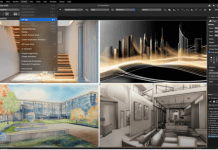When GIS & BIM combine: Unlocking insights from your projects and assets with a next-generation CDE
GroupBC takes a look at the explosion of external data sources that are becoming available such as Geospatial, Land Registry, Ordnance Survey, BIM etc, or iOT, scans and point clouds generated by drones when surveying projects and how you can unlock value and insights from them within digital construction.
Stephen Crompton, GroupBC CTO, briefly explained how it has been GroupBC’s mission over the past 20 years to move the industry forward from the world of unmanaged, unstructured and difficult to extract information into a trusted, structured, and fully audited world of information. He introduces the topic of “The Power of Location” by looking at what we ultimately want to do with that information, how we can make best use of it to answer the questions we have, and how can we be assured that it is current and trusted information throughout the lifecycle of the asset.
He also discussed how GroupBC worked with Thames Water when they wanted a tool to provide quick and easy access to reliable geospatial information that would enable robust early decisions and a reduction of the associated risk, uncertainty and cost around their major programme of works.
Following on from this, our client speaker Trevor Mossop, Technical Services Manager at J T Mackley & Co Ltd, explained how they have embraced this new way of working to deliver significant stakeholder value to their clients and fellow project team members. As the main contractor specialising in flood defence and coastal maintenance projects, most of their work is for the Environment Agency and similar customers, and as such, they needed a CDE to demonstrate BIM level 2 compliance in order to stay on the EA frameworks. Mackley also wanted to streamline their business operations and information management systems through a single solution in the cloud that would enable site workers to be able to access information in the field, rather than relying on network servers or email.
Trevor Mossop discussed the challenges Mackley faced, including his involvement with GroupBC, looking at how to make better, mobile use of geospatial data on the Shoreham Adur Tidal Wall project and how to engage site workers with minimal BIM knowledge or training. Trevor demonstrates on their own system how by uploading self-authored Google Earth KML files to the CDE, Mackley have enabled Field workers – using the map as the most natural, intuitive interface – to access the latest, approved, published information as simply as possible, via shapes and icons on a map.
By driving only appropriate information to workers, through links to pre-defined searches, Mackley can engage users in their BIM journey with minimal training. Information can also be shared with the supply chain and customer in the same manner, enabling them to collate and highlight Health and Safety information or O&M manuals for individual projects or assets via a single click on an icon on the map interface.
Information is also accessible via a QR code that can be printed and attached to an asset, so site workers can simply scan the QR code to access the latest linked information such as risk assessments, method statements etc on site from their mobile or tablet.
Trevor also demonstrates how that information is correctly structured and linked from the CDE to the asset, ensuring only the latest, trusted information is available.
Rounding up the webinar, Sanjeev Shah, GroupBC founder and Director, takes the concept further by looking at Geo-Locating, Geo-Linking and Geo-Referencing Digital Twins and Digital Estates. He explains that a digital twin is the BIM model of an asset containing all the linked data and information that is needed for O&M. Taking an example of one of our customers, Wienerberger, Sanj demonstrates how the digital twin of one of their houses can work with available GIS and open data about the surrounding landscape and infrastructure, as well as within a point cloud of the area and runs through several examples of their work, including use of multiple models and the benefits that can provide.
Sanj also briefly discussed a research project that uses various sensors on a bridge and link to current as well as historic data in BC in order to track movement and displacement by time-slicing through the datasets for comparisons.
Click here to view the whole webinar and then get in touch GroupBC if you would like to discuss how we can help you harness the power of location.













